I’ve finally finished my trip to CES 2019, the big tech trade show in Las Vegas. I walked more than 32.9 miles to scout for the products that can capture my imagination and stand a chance at being best sellers. It’s partly a death march to try to cover 2.8 million square feet of space in five days, but I gave it my best shot at seeing as many of the 4,000 exhibitors as I could.
I was slowed by weariness. But luckily the giant Las Vegas Convention Center central and south halls didn’t have a power outage this year. And I came up with my list of the best of CES, and I hope you enjoy it.
I like how some of these ideas come from non-tech companies, like 182-year-old Procter & Gamble’s first appearance at the show ever. It reminded me of Carnival cruise lines, which gave a keynote at CES two years ago on its wearable for ocean cruises and how you could use it to order a drink and have it delivered to you anywhere on the ship.
This year, once again, we saw technology fade into the woodwork, and the woodwork came alive in a way that solved real problems. In many cases below, I can see larger trends and larger problems that can be solved by more than one company or more than one technology. Sometimes we fret about seeing a bunch of copycats at CES. But it’s good to remember that competition hones the leaders and makes them stronger.
June 5th: The AI Audit in NYC
Join us next week in NYC to engage with top executive leaders, delving into strategies for auditing AI models to ensure fairness, optimal performance, and ethical compliance across diverse organizations. Secure your attendance for this exclusive invite-only event.
I hope some of my picks surprise you, and I am delighted to say that I don’t feel I wasted my time at CES. I feel like I saw our future, just a little bit earlier than everyone else.
Opté Precision Skincare Wand

Above: Dean Takahashi gets the Opté treatment.
Procter & Gamble showed up at CES at with five innovative products, including the Opté Precision Skincare Wand. It scans your skin with a blue LED light to find your age spots. A microprocessor analyzes the age spots and customizes the serum instantly to apply to them. It uses inkjet technology to deposit the customized serum to cover each imperfection, careful to avoid putting the serum on non-blemished skin.
I played guinea pig, and a P&G person waved the wand over my face, magically covering up my age spots. It’s only temporary, and lasts about a day, akin to make-up. But the serum can help improve your skin over time.
It took 10 years of development and over 40 patents to bring it to market. P&G Ventures, a startup studio within P&G, created Opté, with proprietary algorithms and printing technology with skincare. It doesn’t use expensive lasers, lightening creams, or make-up. I’m waiting to see how much it will cost. Funai Electric provided the inkjet microfluidics technology used in the Opté.
Zero Mass Water
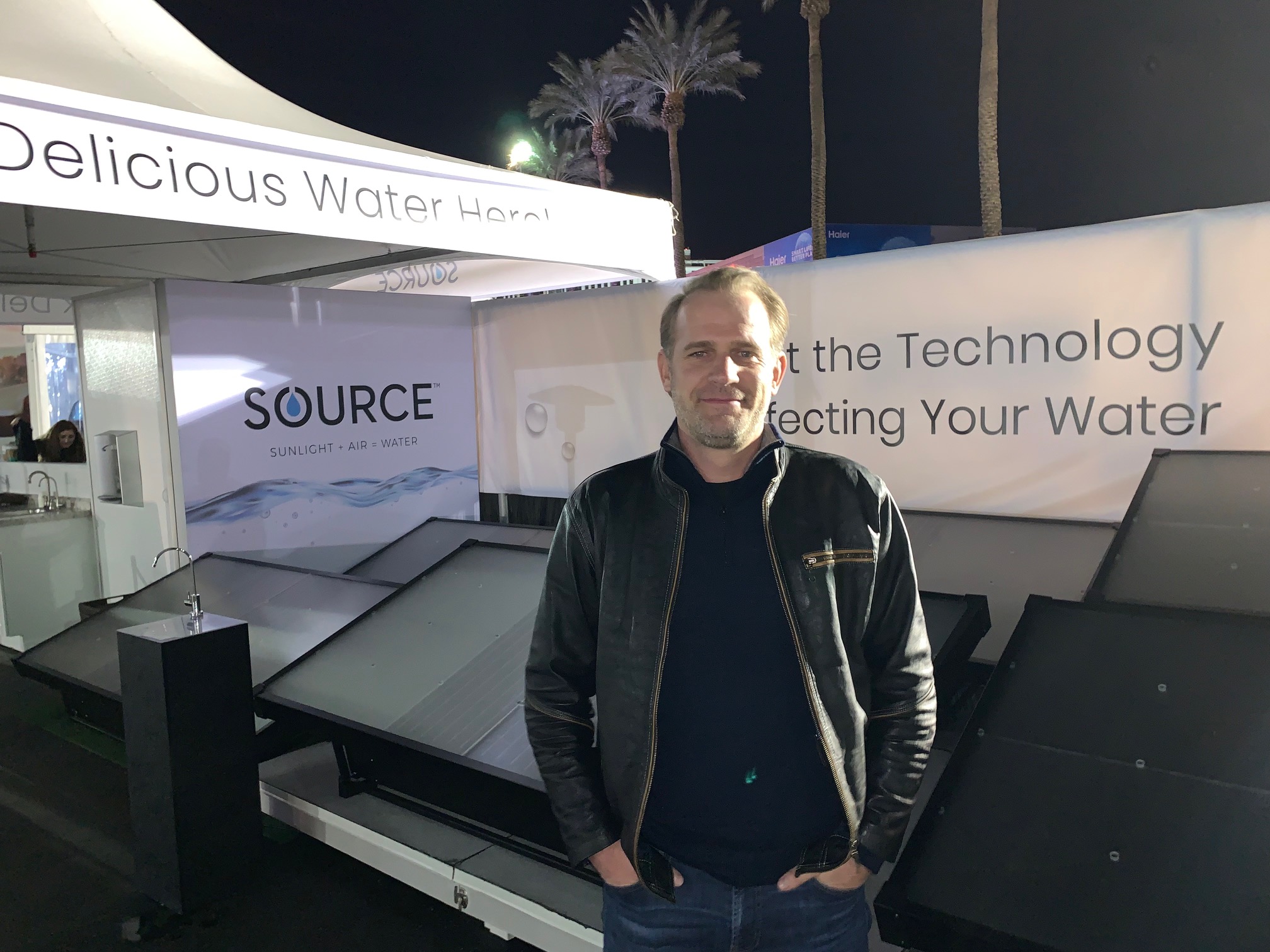
Above: Cody Friesen, CEO of Zero Mass Water, has Source panels that extract water from air.
Zero Mass Water is one of those companies that will change the world. Like something out of Frank Herbert’s classic science fiction novel Dune, Zero Mass Water has created the Source Hydropanel, which can extract water from air and electricity. It does so by using air and solar panels to create the right conditions to speed the process of condensing water from even arid air.
That is magic, as it requires no electrical input, pipes, or public utility infrastructure. It is a way of using the resources that are already in abundance around us — the water that exists in our air.
It is the brainchild of Cody Friesen, associate professor of materials science at Arizona State University. Friesen said his own home in Arizona now operates on a couple of Zero Mass Water’s Source Hydropanels, which produce more than 600 bottles of water a month, or more than enough for his family of four. And he lives in the dry air of Arizona.
Just think of what Zero Mass Water can do for impoverished people — whom Friesen calls the bottom billion — in desert climates around the world. Zero Mass Water came to CES 2019 with a new sensor suite, called Source Informed, that allows it to measure in real time how much water its panels are producing in the world. Used with the Source app, the sensors enable the panels to create the “perfect cup of water,” Friesen said. In the dry Las Vegas air, Friesen handed such a cup to me. And I drank it all in.
Impossible Burger 2.0
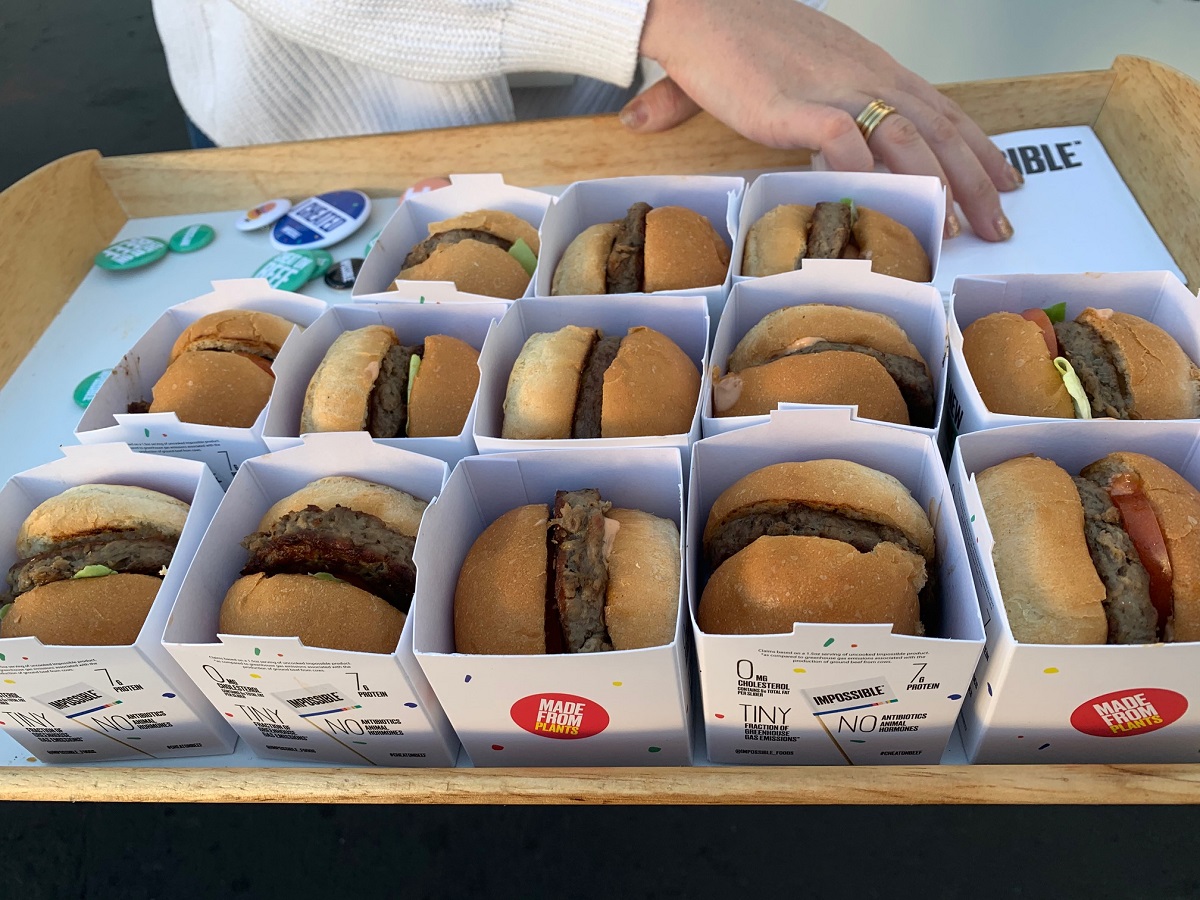
Above: The Impossible Burger 2.0, in slider form.
The Impossible Burger 2.0 is one of those things that seems … impossible. It is made from plants, with less saturated fat than a burger, no cholesterol, and now it is gluten-free. It tastes better than most veggie burgers because it is spiced with heme, an iron-containing molecule in blood that carries oxygen and is found in living organisms.
It was founded eight years ago by scientist Patrick Brown, a Stanford professor who felt that our habit of eating meat wasn’t sustainable. Brown figured out that if he could generate a lot of heme from plants, he could re-create the taste of animal meat.
“If you don’t have heme, you can’t create the authentic meaty smells and flavors of meat,” said David Lee, chief operating officer, in an interview with me at CES 2019.
With funding from Khosla Ventures, Brown started Impossible Foods in 2011. After five years, the company launched its Impossible Burger in restaurants, starting first with celebrity chefs.
He created the Impossible Burger about three years ago, and it is now in 5,000 locations and 49 states, Lee said. The company has about 30 patents on the technology. The company has raised $475 million, and the burger uses 95 percent less land and a quarter of the water of real meat.
But does it taste good? I ate an Impossible Burger 2.0. And it was great. And it makes perfect sense that this came from technology. The new burger will be in a bunch of burger chains by the end of the first week of February.
“CES has never launched a food product until today,” Lee said.
Gillette Heated Razor
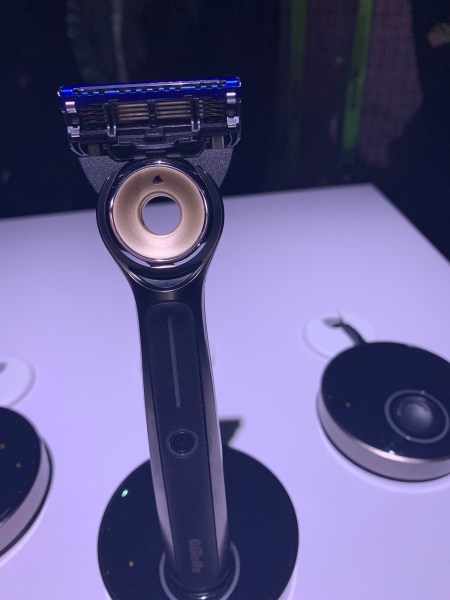
Above: Gillette’s heated razor
We always talk about the wisdom of the razor and razor blades business model. But who would have thought that you could innovate with a razor? P&G also came to its first CES with the Gillette heated razor.
This razor heats itself so you can enjoy a shave with a warm, comfortable blade. It has four heat sensors that continuously heat the razor but are smart enough to shut it down if the heat gets too high. I felt it and it was surprisingly warm, even though it looks like any other fancy metal razor. It charges wirelessly in its magnetic charging dock, and it’s waterproof so you can shave in the shower.
It doesn’t result in a closer shave, but it does make you feel pampered, like a visit to a barber. The heat ranges from 113 degrees Farenheit to 122 degrees. You press a button to heat the razor in less than a second. I’m not sure how much I’d pay for this, but it sure makes a dumb device into a smart one.
Matrix PowerWatch 2
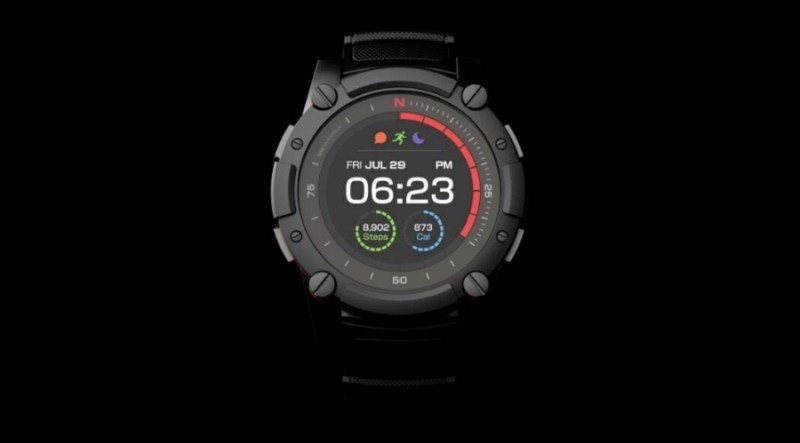
Above: Matrix Industries’ PowerWatch 2
Matrix Industries came up with a clever smartwatch in 2017 that used body heat as its power source. But it lacked the gee-whiz graphics that users wanted and still had to be charged once in a while, and so the company came back to CES 2019 with the PowerWatch 2, which never needs a charge.
The new PowerWatch 2 gathers additional energy from solar power, which all but erases the fear of running out of battery power. The idea came from materials scientists who wanted to change the way we harvest and use previously wasted energy.
The solar cell brings an increase in power, allowing the PowerWatch 2 to come standard with a completely new set of functions, including features like built-in intelligent heart rate monitoring capabilities, a full-color display, and onboard GPS, said Matrix Industries CEO Akram Boukai, in an interview with VentureBeat.
PowerWatch 2 introduces the first full-color LCD display powered by thermoelectric and solar energy, as well as always-on GPS so you can map out your run, hike, or ride. It allows you to leave your smartphone at home. The body heat charging is the big idea. Matrix Industries engineered its advanced thermoelectric generators to operate with extreme efficiency. It created more efficient conversion circuitry to power the electronics and charge the internal battery.
The new watch is expected to debut in June. It costs $200 for early bird preorders, and $500 at retail.
Nvidia GeForce RTX 2060

Above: Real-time ray tracing scene on Nvidia RTX.
Nvidia got a fair amount of grief last fall when it released its expensive Nvidia RTX 2080 Ti and 2080 graphics cards with a feature called real-time ray tracing. Jensen Huang, CEO of Nvidia, heralded the RTX as the future of gaming and 3D graphics, but only Battlefield V — and belatedly so — took advantage of the feature, which enables amazingly complex lighting, shadows, and reflections. Hypothetically, this will be valuable some day as more games use it. But it also brought performance to a crawl.
But Nvidia soldiered on and it launched the GeForce RTX 2060 at the much more reasonable $350 price at CES 2019. It begins shipping next week, and it has a feature — DLSS, or deep learning super sampling — which uses artificial intelligence to sharpen images and speed the frame rate. The RTX 2060 is 60 percent faster on current titles than the prior-generation GTX 1060, NVIDIA’s most popular GPU, and beats the gameplay of the GeForce GTX 1070 Ti.
Games like Battlefield V, Justice, and Nvidia’s own demos show how spectacular the real-time ray tracing graphics can look.
More than 40 gaming laptops are launching this year with RTX graphics and Nvidia’s Max-Q technology. In that sense, the RTX is enabling a whole new generation of innovative laptops and gaming desktops. Nvidia’s Huang said lots of real-time ray tracing games are coming. AMD has its own rival graphics chip coming, but it doesn’t dive into real-time ray tracing just yet.
LG OLED TV R
I’m not sure how expensive it is or how useful either. But the 65-inch LG OLED TV R is an amazing piece of technology. The screen rolls up or down from a base.
When the screen is down, or all rolled up inside the base, the TV screen isn’t visible at all. You can use the base to listen to music, as the base is a Dolby Atmos front-firing soundbar. You can watch it in Line View, with the screen partially unrolled, so you can do things like set the clock. And you can watch it in full view. It works with voice commands via Amazon Alexa, with support for Apple AirPlay 2 and HomeKit.
But the screen emerges from the base, and it’s pretty razor thin. As the screen edge ascends, the screen itself unrolls, rising up to the top so you can watch your shows. LG didn’t say how much it costs.
The models in the video come separately.
HTC Vive Pro Eye
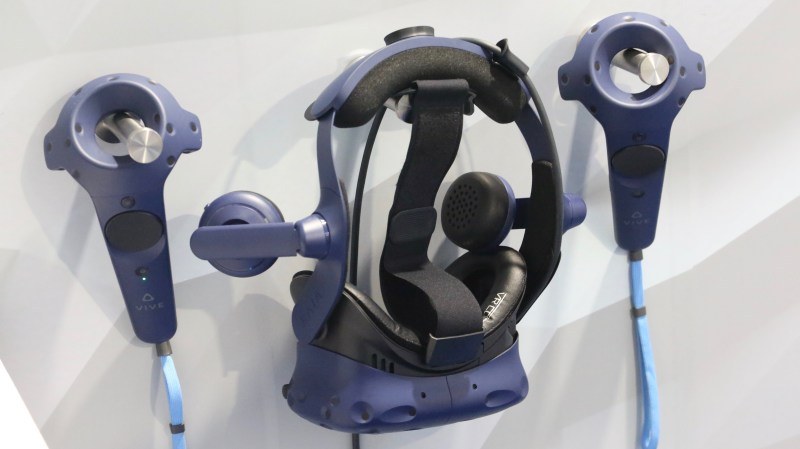
Above: HTC Vive Pro Eye.
HTC’s latest high-end virtual reality headset is the HTC Vive Pro Eye, which comes with integrated eye-tracking from Tobii. This adds a few benefits to the VR experience, as the headset’s camera can now track where you are looking in a VR game or application.
Eye-tracking gives the developer a good clue of where the user’s attention is focused, and that makes it good for analyzing an enterprise training session. It also tells a game developer whether a player is looking in the right place. Eye tracking also enables foveated rendering, which saves on graphics processing capability. With foveated rendering, the hardware only fully renders what you’re looking at, and it leaves the rest of a scene blurry. That enables more efficient rendering, lowers power consumption, and enables better overall performance.
I tried it out and it was very easy to set up, thanks to Tobii’s years of experience in setting up eye-tracking on other devices like the PC. In a demo dubbed MLB Home Run Derby, eye-tracking was used to enable the player to quickly select menu settings just by looking at them. I also became a pilot in Lockheed Martin’s Prepar3D flight simulator, where I used my eyes to complete tasks in a fighter cockpit by looking at them. I ultimately fired some missiles by looking at a target.
This addition will make the Vive headset more expensive, but it also makes it more versatile and useful. I look forward to more applications that use this new feature, which puts VR back on the improvement treadmill on its way to the mass market. The Vive Pro Eye is expected to come out in the second quarter of 2019. But I saw a nice line at Tobii’s booth for people waiting to try it out.
Omron HeartGuide

Above: The Omron HeartGuide reads your blood pressure.
As I said last year, I’ve been waiting a long time for a wearable blood pressure monitor that could prevent people from having heart attacks. Medical giant Omron Healthcare showed off its latest version of the Omron Healthguide, a wearable blood pressure monitor that you can wear as a wristwatch and that can deliver clinically validated accuracy.
This year, Omron is finally shipping it, starting next week, for $500. It’s more expensive than I would like it to be, but that speaks to the value it is delivering. Its battery can last for days, though it depends on how many times you take your blood pressure. You can also use it to track fitness, monitor your sleep, and get notifications.
The Japanese company has also created a digital platform to track and store heart health data and easily share it with your physician. Many companies have shied away from adding such a feature to heart rate monitors because of concerns about regulatory approval. But Omron has received approval.
It has an inflatable band inside the wristband. It can periodically inflate and then capture your blood pressure at different times in the day. It can do so in your sleep, as irregular blood pressure during rest can be an indicator of a serious health issue. (Omron also had a wonderful robot that played table tennis at its booth.)
Zvox’s VoiceBuds
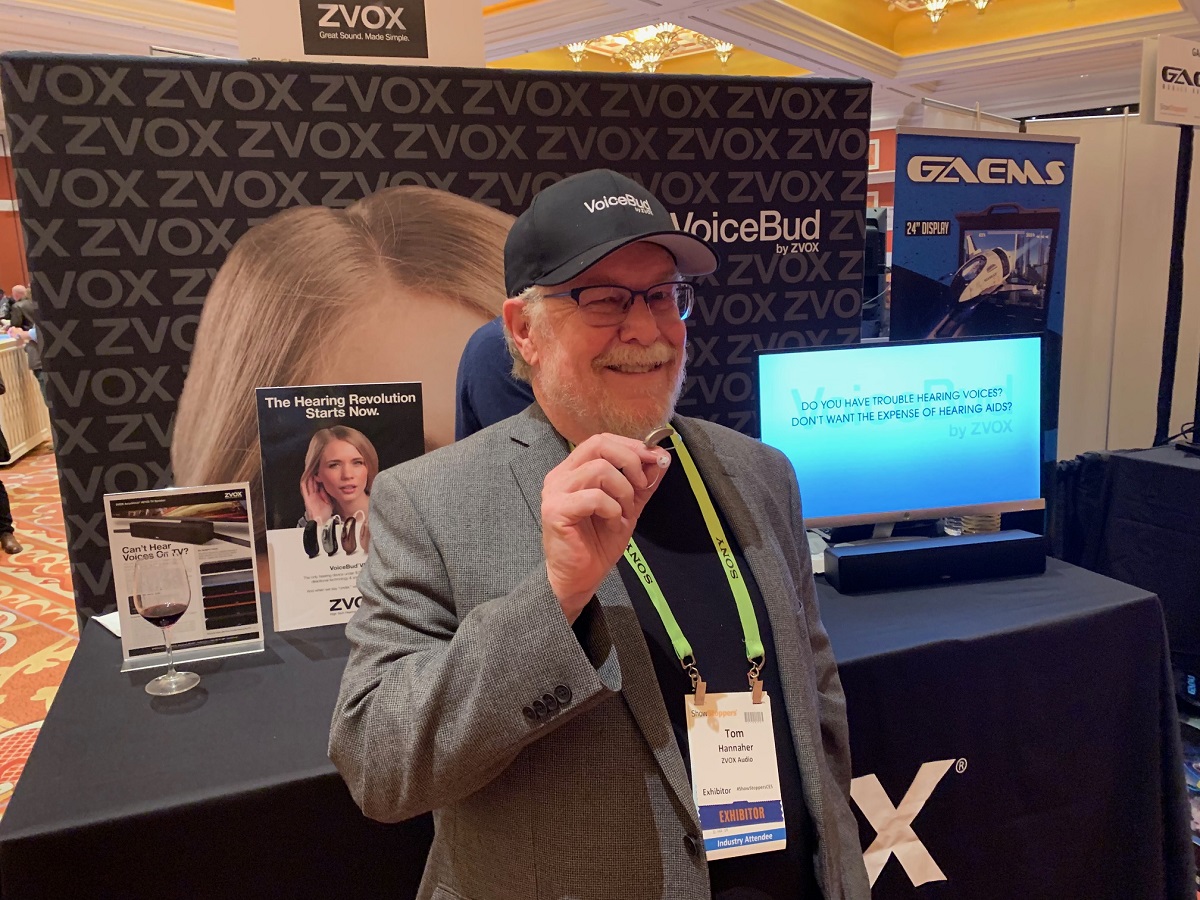
Above: Tom Hannaher is founder of Zvox Audio.
Hearing aids are in need of disruption. My mother paid nearly $5,000 for her latest pair from Hearwell, and we had to visit an audiologist to get them. Senator Elizabeth Warren (D-Massachusetts) was able to pass a bill that could make hearing aids cheaper and much easier to buy, and Zvox Audio is waiting in the wings to offer $300 over-the-counter devices that it, for now, calls VoiceBuds.
These devices have two microphones that enable better hearing, noise cancellation for noisy places like restaurants, and a VoiceBud app that you can use to control volume, listening modes, and check on the battery status. These features are often found in devices that cost more than $600. It also has a way to turn down the sound before really loud noises reach the user’s ears.
This product was one of many that, to my pleasant surprise, was targeted at making life better for older people.

Above: Netgear’s Meural Generation 3.0 Smart Canvas
My honorable mentions include the Neoeffect Neo Mano, Netgear Meural 3.0, Dell 7400 2-in-1, Guardian Optical, SleepScore Labs, DigiLens, Nreal, Royole FlexPai, the Mophie Juice Pack Access, DFree bladder monitor, BreadBot, and Kohler’s Numi 2.0 smart toilet.
